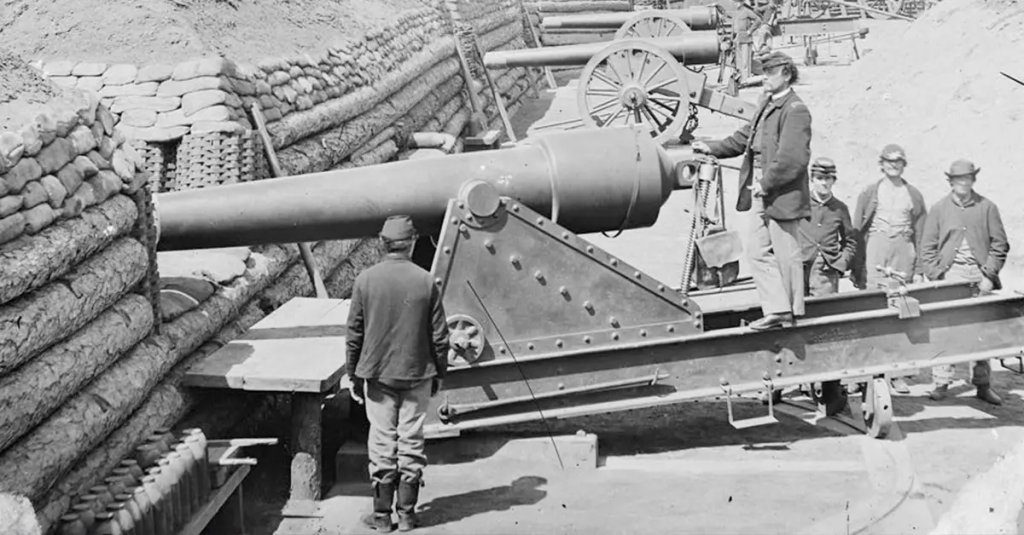Want to win a war game? Plan carefully, work hard and get lucky. Want to win a war? You need to get good (or, “Git Gud,” as you Fortnite players might say). That was the challenge facing military leaders at the start of the Civil War. Industry and daily life had changed year by year over the preceding decades, and if military leaders didn’t evolve and rise to the challenges brought on by the new conflict, they and their men would be lucky to get shallow graves.

(Library of Congress)
The Industrial Revolution took a while to get started and into full swing, but by the 1850s, it was raging across North America with wooden (and, quickly, steel) railroads crisscrossing the country while horses and engines, were pressed into service to pull the train cars. Steam-powered shovels dug canals, and ships crossed the oceans in record time with coal-heated boilers pushing them along.
So, when rebels fired on Fort Sumter in 1861, it was time to use the new manufacturing techniques and technology to improve the weapons of war and produce them on a grand scale. When it came to artillery, the growing industrial might of the U.S. was full of things that could improve cannon design.
Improvements in metallurgy and machining had allowed for more powerful pistons for steam engines, but if you used the same techniques to create cannons, you could safely pack more powder per shot and create more cannons in total. And, the massive improvements in the understanding of iron mining and smelting meant fewer weapons made of brass.
And since machining and interchangeable parts had also improved, it had become possible to manufacture rifled cannons in large numbers. Rifled cannons were more accurate, more destructive, and could deliver explosives into stone masonry.

(Public domain)
These changes had, obviously, begun before the war actually broke out. For instance, the Parrot rifle was created in 1860. It was designed by a former Army captain who had left the service in 1836. It was actually a cannon and relied on a cast-iron barrel, a then-recent development in cannon design, but far from revolutionary.
Cast-iron barrels have better accuracy than those made of wrought iron, but cast iron is brittle and has less tensile strength, essential for surviving repeated firings. Parrot wrapped the cast-iron barrel in wrought iron with a focus on the breech where the worst pressures were experienced. The addition of rifling helped improve accuracy and range.
But the 1861 outbreak of war drastically increased the market for the Parrot rifle and similar weapons. And, it also created a market for new artillery munitions.

(Dr.Stew82, CC BY-SA 4.0)
Explosive shells, chained shot, heated shot, all had been around for a while, but the industrial war had created industrial demand. Again, new manufacturing techniques allowed for many more rounds to be created. But, even better, when well-made explosive shells were fired from rifled cannons, they could pierce walls, drilling feet into the surface before exploding.
This destroyed stone walls and timber fortifications with ease. While Parrot rifles and other long-range artillery, were able to fire up to 1.5 miles or more, wrought-iron, rifled cannons firing smaller shells could reach out over 2 miles.
For defenders, that was a guaranteed catastrophe. Traditionally, forts counted on altitude to outrange their opponents. If opposing artillery had similar weapons, the fort’s defenders gained a considerable range advantage because they were firing from 15-feet above the ground or potentially higher.
But if the attacker showed up with wrought-iron, rifled cannons with reinforced breeches, they’d likely have a huge range advantage. With a cast-iron barrel reinforced by wrought iron, they lose a little range but pick up some serious accuracy.

(U.S. Army Corps of Engineers)
And when the attacker’s shells buried into the walls before exploding, they could shred straight through the defenses while staying outside the range of the fort’s smoothbores.
And this was decidedly in the Union’s favor because it had the factories and money to manufacture these technological marvels.
When artillerymen got into duels with the new weapons, it was an interesting if lethal exchange. But for infantrymen sent against these new guns, meant they could have to march under fire for over a mile to get into range of their attackers. It took 15 to 20 minutes for infantry to cross the distance while each gun’s crew was pushing out two rounds per minute.
Between that and breakthroughs in rifle technology (similar story to artillery, improved manufacturing techniques combined with improved range and rate of fire) made an infantry attacker’s job nearly impossible. The worst was Pickett’s Charge at Gettysburg where 15,000 Confederates tried to cross .75 miles of open field under artillery and rifle fire. Nearly 6,000 men died, and the rest retreated.


